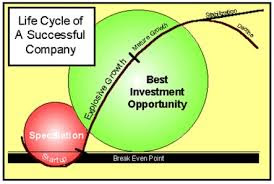Rapid growth in revenue and earnings may be top priorities in corporate boardrooms, but these priorities are not always best for shareholders. We are often tempted to invest large amounts in risky or even mature companies that are beating the drum for fast growth, but
investors should check that a company's growth ambitions are realistic and sustainable.
Growth's Attraction
Let's face it, it's hard not to be thrilled by the prospect of growth. We invest in growth stocks because we believe that these companies are able to take shareholder money and reinvest it for a return that is higher than what we can get elsewhere.
Besides, in traditional investing wisdom, growth in sales earnings and stock performance are inexorably linked. In his book "One Up on Wall Street," investment guru Peter Lynch preaches that
stock prices follow corporate earnings over time. The idea has stuck because many investors look far and wide for the fastest-growing companies that will produce the greatest share-price appreciation.
Is Growth a Sure Thing?
That said, there is room to debate this rule of thumb. In a 2002 study of more than 2,000 public companies, California State University finance professor Cyrus Ramezani analyzed the relationship between growth and shareholder value.
His surprising conclusion was that the companies with the fastest revenue growth (average annual sales growth of 167% over a 10-year period) showed, over the period studied, worse share price performance than slower growing firms (average growth of 26%). In other words, the hotshot companies could not maintain their growth rates, and their stocks suffered.
The Risks
Fast growth looks good, but companies can get into trouble when they grow too fast. Are they able to keep pace with their expansion, fill orders, hire and train enough qualified employees? The rush to boost sales can leave growing companies with a deepening difficulty to obtain their cash needs from operations. Risky, fast-growing startups can burn money for years before generating a positive cash flow. The higher the rate of spending money for growth, the greater the company's odds of later being forced to seek more capital. When extra capital is not available, big trouble is brewing for these companies and their investors.
Companies often try increasingly big - and risky - deals to push up growth rates. Consider the
serial acquirer WorldCom. In the 1990s, the company racked up growth rates of more than 20% by buying up little-known telecom companies. It later required larger and larger acquisitions to show impressive revenue percentages and earnings growth. In hopes of sustaining growth momentum, WorldCom CEO Bernie Ebbers agreed to pay a whopping $115 billion for Sprint Corp. However, federal regulators blocked the deal on antitrust grounds. WorldCom's prospects for growth collapsed, along with the company's value.
The lesson here is that investors need to consider carefully the sustainability of deal-driven growth strategies.
Being Realistic About Growth
Eventually every fast-growth industry becomes a slow-growth industry. Some companies, however, still pursue expansion long after growth opportunities have dried up. When managers ignore the option of offering investors dividends and stubbornly continue to pour earnings into expansions that generate returns lower than those of the market, bad news is on the horizon for investors.
For example, take McDonald's - as it experienced its first-ever losses in 2003, and its share price neared a 10-year low, the company finally began to admit that it was no longer a growth stock. But for several years beforehand, McDonald's had shrugged off shrinking profits and analysts' arguments that the world's biggest fast-food chain had saturated its market. Unwilling to give up on growth, McDonald's accelerated its rate of restaurant openings and advertising spending.
Expansion not only eroded profits but ate up a huge chunk of the company's cash flow, which could have gone to investors as large dividends.
CEOs and managers have a duty to put the brakes on growth when it is unsustainable or incapable of creating value. That can be tough since CEOs normally want to build empires rather than maintain them. At the same time, management compensation at many companies is tied to growth in revenue and earnings.
However, CEO pride doesn't explain everything: the investing system favors growth. Market analysts rate a stock according to its ability to expand; accelerating growth receives the highest rating. Furthermore, tax rules privilege growth since capital gains are taxed in a lower tax bracket while dividends face higher income-tax rates.
The Bottom Line
Justifications for fast growth can quickly pile up, even when it isn't the most prudent of priorities. Companies that pursue growth at the cost of sustaining themselves may do more harm than good. When evaluating companies with aggressive growth policies, investors need to determine carefully whether these policies have higher drawbacks than benefits.
Read more: http://www.investopedia.com/articles/fundamental/03/082003.asp#ixzz2KA5lFtVB
